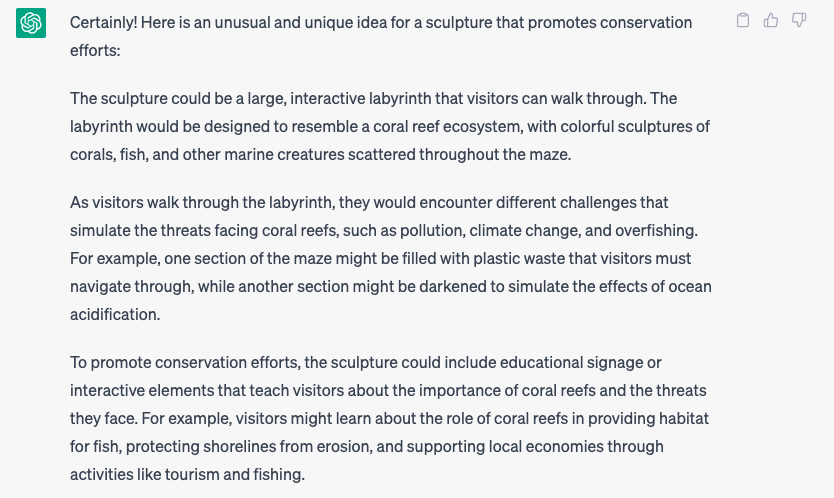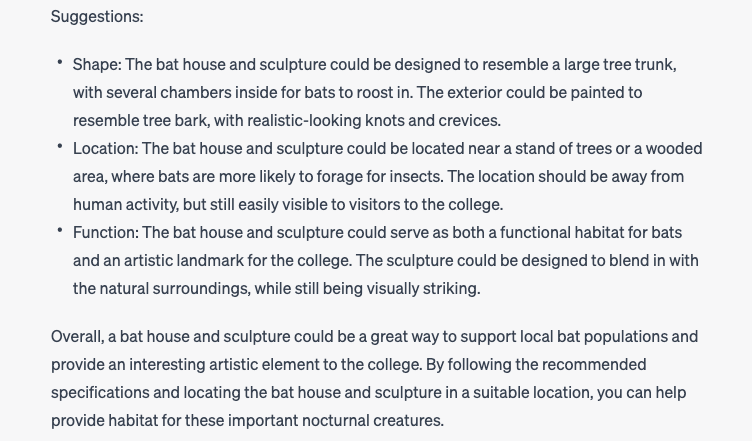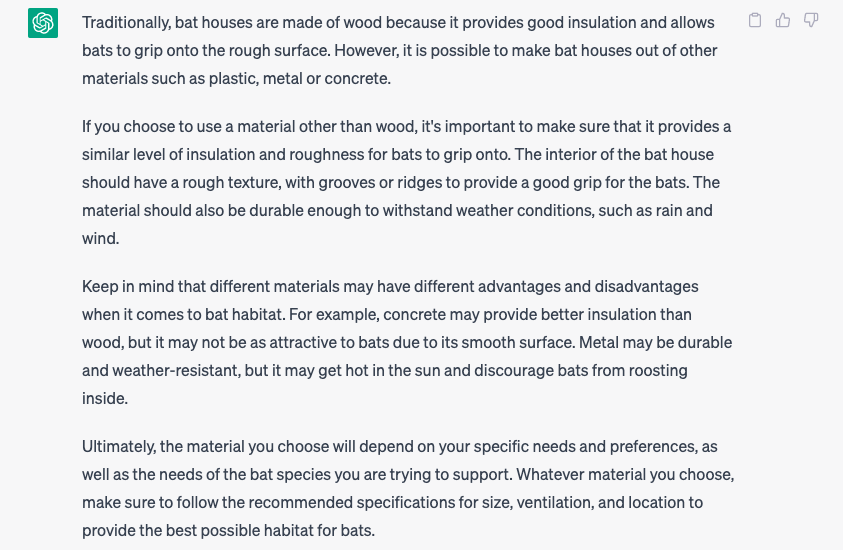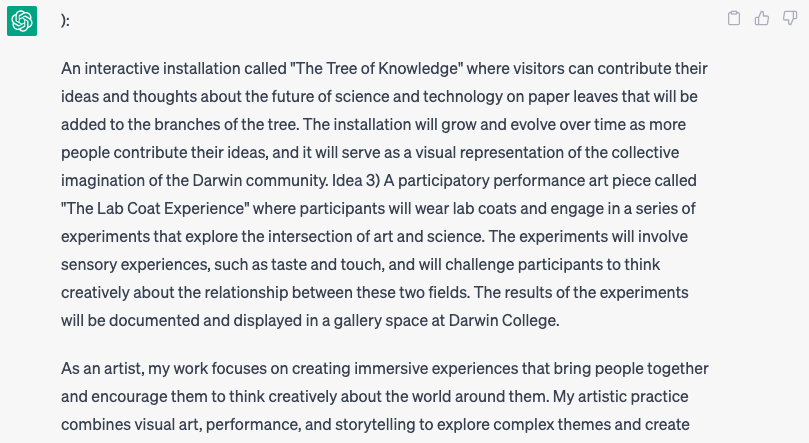ChatGPT thinks I’m a Criminal and won’t date me.
Two months ago, the Faculty of Education at the University of Cambridge sent students an email concerning ChatGPT. This warned of the strict guidelines on student conduct and academic integrity, stressing that students must be the authors of their own work, and that the use of AI platforms such as ChatGPT would be dealt with under the University's disciplinary procedures. Though the email conceded that AI platforms were now being used as research tools worldwide, it stressed issues related to biases in the current information searching model, the questionable accuracy of content, and ethical concerns related to the use of large datasets and gathering data from users. In response I logged onto Open AI for a cheeky look. I had mixed results.
I started slowly, asking for simple facts such as the ISBN and DOI numbers of books I had in front of me. Then I pasted a few BBC articles into the platform and asked it to summarise them. All of this was accurate and instantaneous.
Next, I wanted to test its creativity:
The pitch it came up with was a sculptural birdhouse which would have some aesthetic and conceptual function alongside being a practical birdhouse to support the wildlife in our garden. I was quite excited about this idea, because I have been envisioning this exact project ever since I created artwork for Cheongju Arts Council in 2015 and 16 - in which an abandoned cigarette factory was opened up for the first time since the 1980s. The building had only been inhabited by pigeons for decades and the floor was inches deep with bird poop, bones, feathers, full carcasses and recent eggshells - it was a biological monument to generations of pigeons, displaying life, death and rebirth. An incubator and a mausoleum. The projects: The Butterflies of Andokbul and The Mother Crowns of Neo Joseon were made here.
The Mother Crowns of Neo Joseon - Crown of Stories (Those white bits on the floor are feathers, egg shells, and bones…)
Since the council were about to displace the birds, I began pondering on a giant sculpture to re-home the pigeon population. So I liked it very much when ChatGPT offered this suggestion. However, the value of the work would be entirely in the narrative the artist brought to it and the execution - otherwise the idea is essentially “make a novelty bird house”. Curious, I went on to ask some more questions.
I asked it to pitch an artwork about the local otter population, and it suggested a life-size sculpture of an otter made from recycled materials. Now, I’m from Brighton, so I grew up around underwhelming sculptures of animals made from bits of driftwood and recycled crap. I dropped that and asked it to pitch a project related to our Darwin domestic bee population, and it suggested a sculpture which doubles up as a bee hotel or hive. I asked it about the hedgehog population and it suggested a sculpture which doubled as a hedgehog shelter. I asked it about bats and it suggested a bat house. I asked it about wildflowers, trouts and swifts - all local to our garden - and it suggested life-size sculptures of each made from recycled materials.
Okay, so I was seeing a formula here… Is it stuck in a loop? In design we call this “fixation“. Perhaps my questioning was too limited.
So then I changed it up. In design we often focus on clients, sites, research and ideation tactics in order to avoid fixation, so asked it to pitch artworks to specific professors, fellows and the Master of the College. However, again, it suggested bird houses and life-sized sculptures of animals using recycled materials. I was impressed with the comprehension of the tasks and the cache of information it gave me about each client, but as an ideation tool it seemed to be quite limited.
*Few*
I breathed a sigh of relief; in its current form this AI could never replace me. It reminded me of those kids who excel in the academic subjects at school but really struggle with creative or problem-solving tasks, and in an effort to dominate the class spew facts and figures at everyone with tenuous analytical or generative ability. I addressed this directly and requested: “Could you suggest an idea with the same brief, but a very unusual and unique idea, unlike the type of conservation art we are used to seeing?” It replied with an experiential pitch about the dangers to coral reef populations - which, although more dynamic, totally failed to meet the site-specificity or client factors of the brief:
Cambridge doesn’t have a shoreline… or a coral reef… So I backtracked and leant into the idea of the bat house. I asked for project specs: “Please can we develop the bat house sculpture idea? What specifications would it be required to meet and what shape and location would you suggest?” ChatGPT gave me very good product analyses of existing human-made bat houses with dimensions, materials, sites and placements - all the things a good design spec would include:
These specs are incredibly useful to begin a project with, and ChatGPT did all that research and product analysis in seconds. It is worth pointing out that the “shape“ part of the question was very uninteresting and unoriginal. An AI visual platform would do very well with this brief though, something like Midjourney or Dall.e. There are plugins which allow these two types of platforms to develop conceptual and visual outputs together, which makes me quite uneasy…
I don’t want to be limited to wood, so I challenged the materials it suggested and it gave me a solid reasoning for its choice, alongside alternatives and explanations:
It began to hit me that although ChatGPT was not yet capable of creating ideas which were intellectually stimulating to me, it was very good at giving me all the dry information I would usually need to research thoroughly for myself - the technical parameters. A very quick way to stand on the shoulders of giants who came before. So what does it know about artists and the art world?
Curious, I went on to ask ChatGPT about where its art-related data sets came from. It listed a few sources I’ve been covered in, so I asked it about myself. The response was a weird mixture of true statements and total fabrications. Mostly fabrications, to be honest:
It has clearly mixed up my Seoul-based studio, “The Bite Back Movement”, with “Bite Back”, the animal rights group. It also claimed that I was a painter trained in the University of Leeds - which are both very much not true. ChatGPT does make me sound very interesting - but there are clear ethical issues associated with this type of error - especially if I were to apply for a job working with children or vulnerable populations and there were questions surrounding my criminal convictions - of which, in reality, I have none. It’s a little disconcerting.
I turned my attention back to making artwork. I pulled in a real proposal I was working on about future foresight and art + science, and asked ChatGPT to flesh it out and finish it. At that point I think it had a bit of a breakdown because it gave me a sad face, followed by a couple of really pedestrian interpretations of my proposal involving trees and lab coats. It then went on to generate dialogue from my perspective about my bio:
I started to get bored and asked ChatGPT for a date - but it was having none of my shenanigans… very cold indeed!
Finally, seeing as it had some insights into my biography already, I asked ChatGPT what my next artwork should be; “What would you suggest Alexander Augustus’ next artwork should be?” This was the answer:
I couldn’t agree more. So I guess it’s time to go outside and collect more experiences. Having an interesting life and unique insights is the only way I think artists can stay one step ahead of imitation. As a research tool I have fallen a little in love with ChatGPT, and I will be keeping it open in my browser for the foreseeable future.










